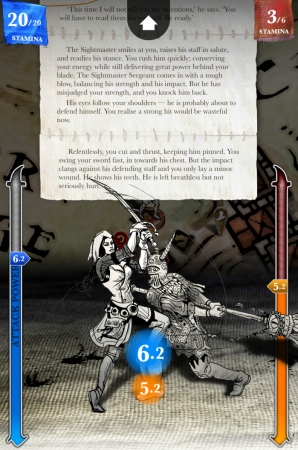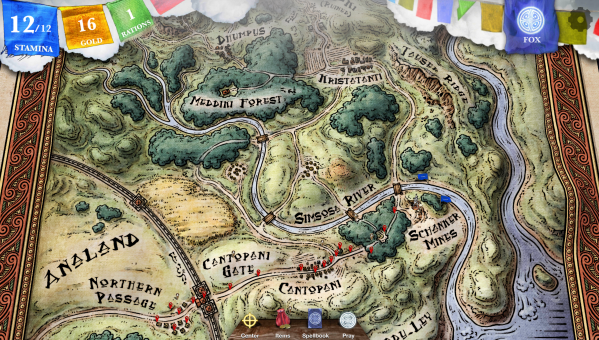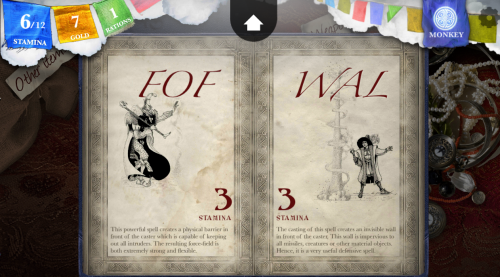![]() As the interest in board games continues to rise, so too does the interest in exploring new ways of playing those games. One such way is through digital ports of those games – translating them PCs, consoles, phones, and tablets.
As the interest in board games continues to rise, so too does the interest in exploring new ways of playing those games. One such way is through digital ports of those games – translating them PCs, consoles, phones, and tablets.
Few people advocate that the digital counterpart to a beloved board game should replace it, but many designers add subtle tweaks to the game that make them great alternatives for solo play, or as a supplemental way to enjoy the game. We don’t wish to completely dismiss their existence entirely, and so we welcome you to the Pixel Provinces.
Sorcery!
Steve Jackson originally published the four-book Sorcery! series in the 1980s, and the digital game port of these books was released last year on Apple devices. The Android version came out on March 12th, and that’s the version I played for this piece.
Sorcery! is a digitalized version of a single-player roleplaying game, and it walks the line between interactive fiction and RPG without falling entirely into one camp or the other. It’s simple and intuitive enough for casual fans to appreciate, but there’s enough puzzle-y turns and hidden treats to keep fans entertained for a little while.
Overall, the story of Sorcery! is a product of its time and genre. It’s a classic medieval fantasy adventure: a brave hero sets forth to save the kingdom from certain doom. Along the way he (or she) encounters monsters, wolves, wolf-monsters, and needy villagers. Battles are won, taverns are visited, ale is consumed. The narrative is a one most gamers are comfortable with, and I’m not familiar enough with the original Sorcery! books to say whether there are any significant alterations from the paper version.
I am, however, familiar with interactive fiction and roleplaying, and it is those aspects of the game book that I looked at.
In Sorcery, you interact with the game primarily from the map screen. This is a lovely piece of detailed fantasy cartography done in the style of yore, complete with squiggly rivers and jagged mountains. Here, you move your avatar (a small, hand-drawn man or woman) by tapping and dragging them to the next plot point. Plot points are denoted by flags on the map, and you typically have two of them to choose from at any time. Once you click on one, the other becomes inactive. Completionists shouldn’t worry though, because you can click on any previous flag and replay the game from that point on. It’s a bit like cheating, yes, but Sorcery! is a choose-your-own-adventure more than a traditional RPG, so you’ll be forgiven for leaving your finger on your previous page.
 Each of the flags will bring you to an encounter. These are described to you through text, usually no more than a paragraph or two at a time, presented toward the top of the screen. Your potential responses are listed along the bottom, and as you make choices and the narrative grows, the text above expands to include your actions.
Each of the flags will bring you to an encounter. These are described to you through text, usually no more than a paragraph or two at a time, presented toward the top of the screen. Your potential responses are listed along the bottom, and as you make choices and the narrative grows, the text above expands to include your actions.
The battle system works similarly, and this is something you’ll encounter with regularity. Everywhere you turn, there’s something to fight, but the system is intuitive and the game is generous with its tutorials. Once you enter combat, a description of the ongoing fight appears at the top of the screen. Below that, your avatar faces off with the enemy. During each round of combat, you can choose to Attack or Defend, and you only have one stat to be concerned with: Stamina.
Sometimes, the description of your enemy will give you a hint as to whether they’re about to charge or dodge, but ultimately the game is extremely forgiving and a loss in battle amounts to nothing more than the battle re-starting. Sorcery is set up in this regard to be more about the interactive story narrative than requiring you vanquish every foe with a lot of time and energy.
1-vs-1 combat isn’t the only solution to your problems, though. Like any proper medieval fantasy setting, there’s a magic system – this one having the benefit of being designed by Steve Jackson and, therefore, being based entirely on puns. While this does ruin a bit of the immersion, the levity is generally welcome. Before setting out, players are given a spell book full to bursting with 48 separate incantations for any and all occasions. Some require special tokens to be cast, but most merely demand a few points of stamina. Each spell is comprised of three letters, and while the game doesn’t force you to memorize them, the names often hint at the spell’s use.
Casting a spell is more than simply selecting from a list. When you choose to cast a spell, you’re brought to a screen full of letters in the shape of a sphere. The ones most likely to be of use to you are presented in the front, though you can choose from anything you see. You tap a letter to select it, and when you do the game presents you with the next letter in the spell. Often, you’re only given one, but if two spells begin with the same letter, you could be asked to choose between them. You can’t access the spell book directly from this screen, and it’s easily the most challenging part of the game.
Ultimately, Sorcery! is a nostalgic exercise, but its one that has some hope of capturing new eyes. With line art reminiscent of the early days of roleplaying and a mostly intuitive digital interface, it balances familiarity with novelty, and it comes out stronger for it. While I would never advise you to skip your regularly-scheduled game night to play Sorcery!, it’s a fun and simple way to get that epic-quest feeling without the commitment of a traditional RPG.
Steve Jackson’s Sorcery! is available on Google Play, Amazon Store, and Apple’s App Store.
![]()
Feel free to share your thoughts with us over on our social media pages!
Photo Credits: Artwork by Inkle Studios.


